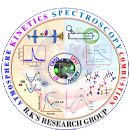The relative yields of products of the reaction of Cl atoms with 1-alkenes (C4�C9) were determined to see whether H atom abstraction is an important channel and if it is to identify the preferred position of abstraction. The presence of all the possible positional isomers of long chain alkenones and alkenols among the products, along with chloroketones and chloroalcohols, confirms the occurrence of H atom abstraction. A consistent pattern of distribution of abstraction products is observed with oxidation at C4 (next to allyl) being the lowest and that at CH2 groups away from the double bond being the highest. This contradicts with the higher stability of allyl (C3) radical. For a better understanding of the relative reactivity, ab initio calculations at MP2/6-311+G (d,p) level of theory are carried out in the case of 1-heptene. The total rate coefficient, calculated using conventional transition state theory, was found to be in good agreement with the experimental value at room temperature. The preferred position of Cl atom addition is predicted to be the terminal carbon atom, which matches with the experimental observation, whereas the rate coefficients calculated for individual channels of H atom abstraction do not explain the observed pattern of products. The distribution of abstraction products except at C4 is found to be better explained by reported structure activity relationship, developed from experimental rate coefficient data. This implies the reactions to be kinetically dictated and emphasizes the importance of secondary reactions.
-
Call
-
E-mail
Journal Details
1. Is H Atom Abstraction Important in the Reaction of Cl with 1-Alkenes?.
M. P. Walavalkar, S. Vijayakumar, A. Sharma, B. Rajakumar and S. Dhanya Phys. Chem. A, , 4096-4107, 120
